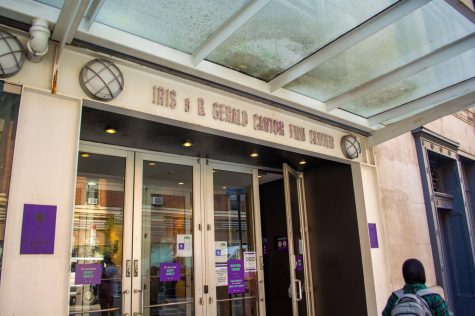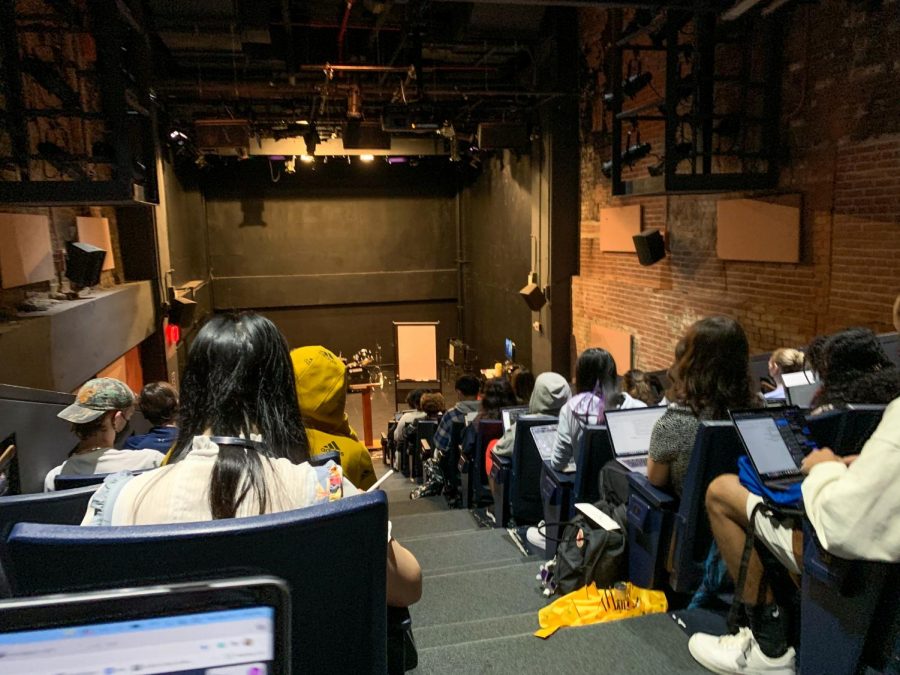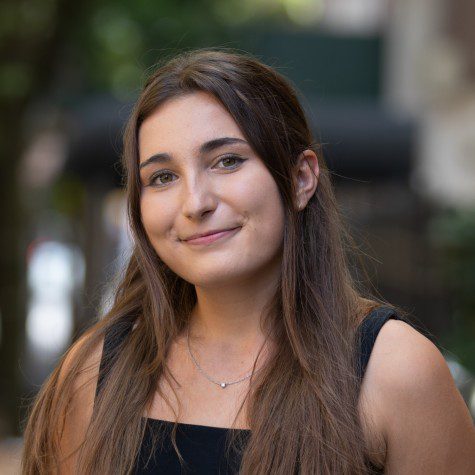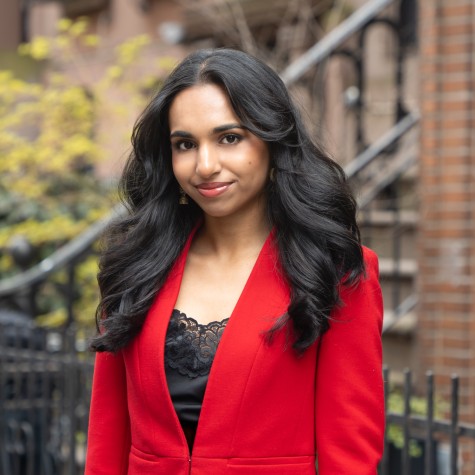Packed classrooms provoke COVID concerns
NYU returned to full in-person instruction this fall, but students are concerned about large class sizes, limited room for social distancing and contrasting rules for academic and non-academic spaces.
Many students are experiencing crowded classrooms in NYU buildings. The high-density classes contrast with the guidelines that NYU is implementing in other areas of student life. (Photo by Olivia Hughart)
September 29, 2021
Despite the university’s COVID-19 guidelines for the fall 2021 semester, some students believe classroom regulations are too lenient. Students are frustrated that though on-campus housing, dining halls and student organizations are regulated, they are often required to sit shoulder-to-shoulder in large lecture halls.
On most weekdays, hundreds of NYU students queue to enter the Iris & B. Gerald Cantor Film Center, which houses multiple large auditorium-style classrooms, each of which can seat over 170 people. When NYU first reopened for in-class instruction during the 2020-21 academic year, classroom capacities were capped to allow for social distancing. This semester, however, NYU removed capacity limits in most academic spaces, citing a high student vaccination rate.

Instead, according to NYU spokesperson John Beckman, the university instituted a new multi-layered safety plan, which included mandatory vaccinations, upgraded heating, ventilation and cooling systems in classrooms and required masking.
“With these and other measures in place, such as having a testing program in place, having a contact tracing program in place, and ensuring our air handling systems are in line with CDC guidance — we are not relying on physical distancing (and its consequent impact on classroom capacity) as a mitigation measure this year,” Beckman wrote in a statement to WSN.
In a Sept. 21 email to the NYU community, university leadership shared a progress update including faculty and staff vaccination rates and data from recent university-administered testing, and reemphasized their belief that COVID-19 was not being transmitted in classrooms.
“Importantly, neither we — nor peer institutions — are seeing transmission in the classroom setting,” the email said. “Most of the cases appear to be attributable to settings where people are not wearing masks: people who live together or social gatherings where attendees were not conscientious about wearing masks — especially with leisurely eating and drinking.”
Reported cases have remained relatively low, with the university reporting a positivity rate of 1.10% for the week of Sept. 20 through Sept. 26. A total of 3,622 tests were reported, of which 40 were positive. Additionally, vaccination rates are high, with 99% of students and faculty and 96% of non-teaching staff fully vaccinated.
Despite these figures, students expressed mixed feelings regarding classroom COVID-19 safety, and sensed a disconnect between regulations enforced in classrooms versus those enforced in non-academic settings.
Steinhardt junior Srinidhi Ananth said that large class sizes, such as her biochemistry lecture, leave little room for social distancing.
“Honestly, I do feel kind of uncomfortable at times because we are close together, and there’s no social distancing,” she said. “Sometimes people are sick and they come to class, so they’re sneezing and coughing.”
Steinhardt junior Sam Levy said he would feel more comfortable in his classes if there was an empty seat between himself and other classmates.
“It would be nice to have at least four feet of space with the desks, but in a couple of my classes it just doesn’t seem physically possible with the number of students they’ve allowed into the sections,” Levy said.
CAS sophomore Nicole Orrego is concerned about the lack of social distancing in her large introductory biology course, since her dad has a heart condition and she frequently returns home to visit.
“There is always that chance that if the person sitting next to me has COVID-19, then I could bring it back home,” Orrego said. “That doesn’t make me feel safe, especially at an institution where I’m paying so much money and there are so many resources that they have at hand to prevent that from happening.”
The university’s guidelines differ for students living on and off-campus — commuter students, for example, are not moved to temporary housing if they test positive or are required to isolate. Steinhardt senior Haley Nemec is concerned that students living off campus will unknowingly spread the virus to other students.
“Some people in my classes don’t wear their masks fully,” Nemec said. “Some people have them halfway on and no one is telling them not to. My professors don’t comment on it.”
While Nemec has professors who do not appear to enforce COVID-19 guidelines, she said others are nervous that crowded classrooms will lead to super-spreader events.
“I have a few classes that are in conference rooms in Rubin that aren’t even real classrooms and my professors have said how stressed they are about it because there is no ventilation because there are like 15 people in one small conference room,” she said. “It’s a room with a big circle table where everyone is sitting within an inch of each other. I’ve had a lot of professors complain about it.”
CAS sophomore Annie Kong is also frustrated with the university’s contrasting guidelines.
“Why can I be in a lecture hall with 200 people but I can’t even go to one person’s room?” Kong said.
Students offered potential solutions to curb their class size-related anxiety. Kong suggested mandatory assigned seating — which was in place during the 2020-21 academic year — to reduce exposure to large groups of students, while others proposed smaller class sizes, more remote options and multiple sections being offered for larger classes.
“My organic chemistry class has 500 students, but they have broken it up into different sections during the week,” Orrego said. “If they could’ve implemented something like that, it definitely would’ve helped out a lot more.”
All of the students WSN spoke to said that the university must do more to ensure that NYU does not become a hotbed for breakthrough cases of COVID-19.
Contact Abby Wilson and Alisha Meghani at [email protected].





























































































































































